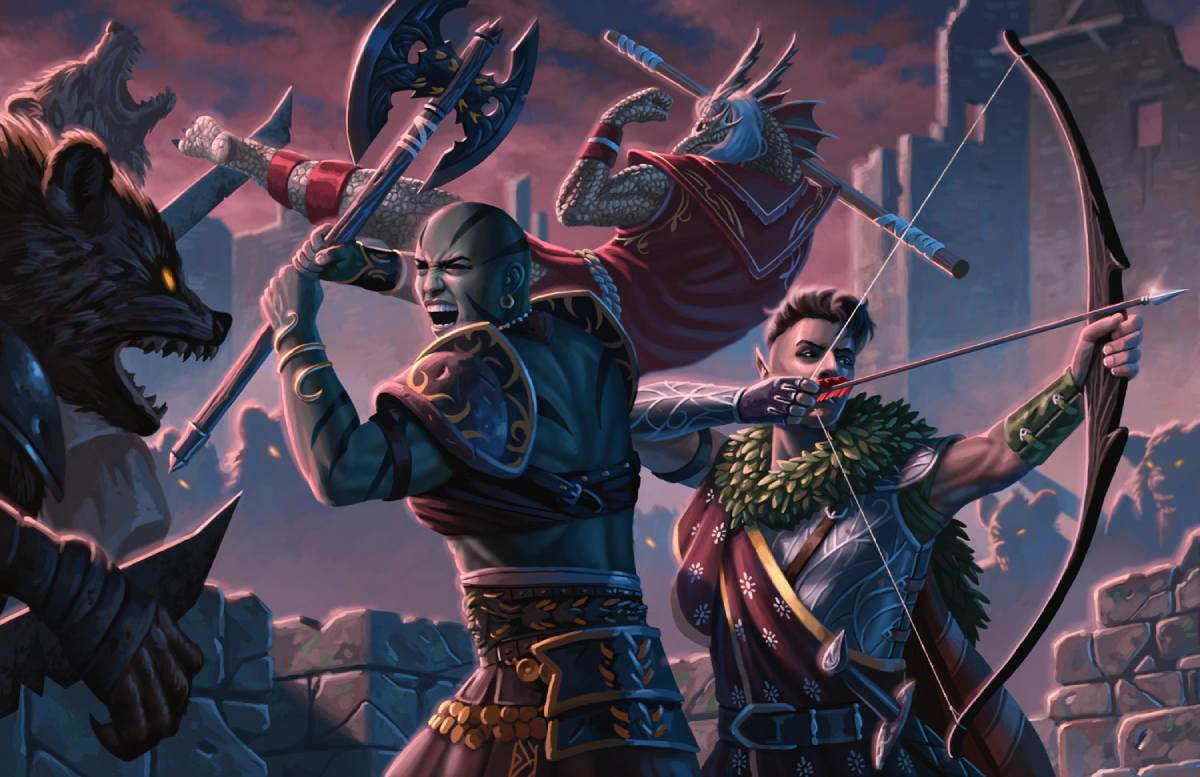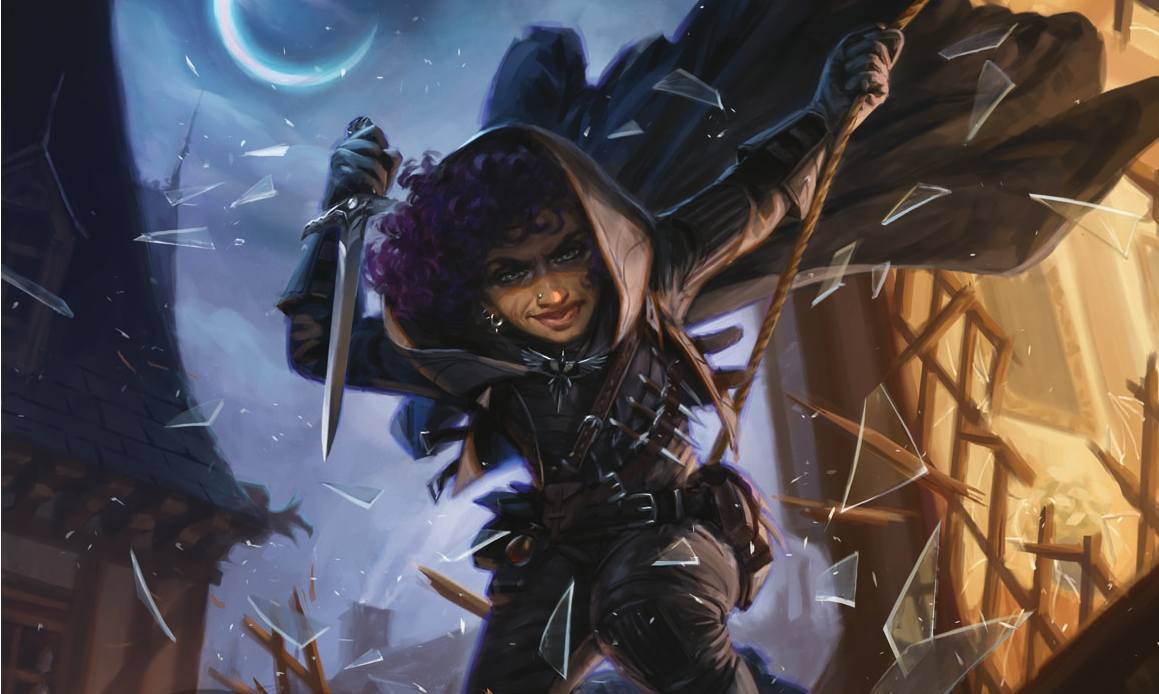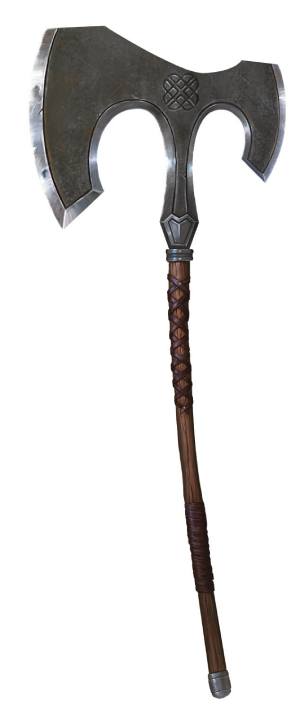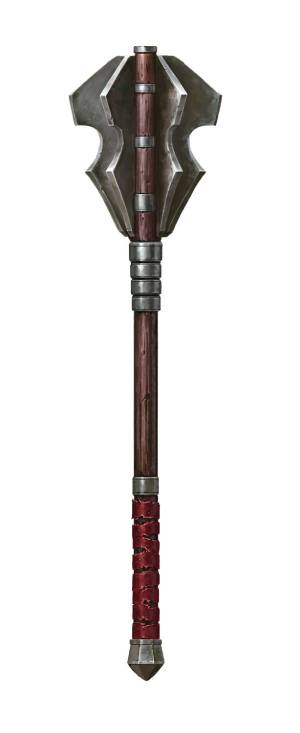The Fighter uses their Maul to knock down their opponent, the Rogue dances around with their Rapier to find their foe’s weak point, and the Barbarian swings a Greataxe through two enemies with a single blow. Every character in D&D has a unique flare they bring to combat, and that’s reflected in the new Weapon Mastery feature in the Player’s Handbook!
Let’s explore these fresh ways to utilize your weapons in the upcoming core rulebook revamp!
Build Your Warrior Today
Start building your weapon-wielding warrior today in D&D Beyond's Character Builder. You can access Weapon Mastery for free using the D&D Beyond Basic Rules, so you can test out this new brand-new system and start cutting a heroic path through your foes!
What is Weapon Mastery?

Weapon Mastery is a class feature shared between some martial classes that reflects their specialization with certain types of weapons.
Each weapon in the Equipment section of the 2024 Player’s Handbook lists a mastery property in addition to the weapon’s regular properties. If the weapon meets the requirements in your class's Weapon Mastery feature, you can learn its mastery property and use it in combat.
But learning a mastery property isn't permanent. If you stumble across a shiny new +1 Longsword and want to learn its mastery properties instead, don’t worry! During a Long Rest, you can practice weapon drills and swap out one of your weapon choices at the end of the rest.
The number of mastery properties you can learn is specified in your class's version of the Weapon Mastery feature. Rogues, rangers, and paladins can only access two mastery properties at a time, whereas barbarians and fighters start with two and three, respectively, and eventually gain access to more mastery properties, as detailed in their Features table.
At level 1, Barbarians, Fighters, Paladins, Rangers, and Rogues get access to the mastery properties for certain types of weapons, as listed below:
- Barbarian: Simple and Martial Melee weapons
- Fighter: Simple and Martial weapons
- Paladin: Based on weapon proficiencies (Simple and Martial weapons)
- Ranger: Based on weapon proficiencies (Simple and Martial weapons)
- Rogue: Based on weapon proficiencies (Simple weapons and Martial weapons with the Finesse or Light property)
Mastering Weapon Mastery
Some subclasses allow you to access more mastery properties. For example, the Soulknife Rogue can use the Vex mastery property with their Psychic Blades and it doesn’t count toward their learned Weapon Mastery limit.
How to Use Weapon Mastery Properties
If you’re wielding a weapon and have learned its mastery property, you’ll be able to use that mastery property every turn when you make an attack with the weapon.
Different mastery properties have different triggers. For example, Cleave requires you to hit a creature with a melee attack roll while Graze triggers when you miss a creature with an attack roll.
Unlike some abilities, there’s no limit to how many times mastery properties can be used per Short or Long Rest, so go nuts!
Mastery Properties Overview

Below, we’ll cover each of the eight mastery properties included in the 2024 Player’s Handbook. We’ll even throw in some tips to help you brainstorm ideas for your new characters!
Cleave

Example Weapon: Greataxe
If you’ll be wading into the thick of battle, you’ll want to consider grabbing a weapon with the Cleave property.
These heavy weapons can slash through opponents. If you hit a creature with a melee weapon attack, you can make a second attack against a creature within 5 feet that is also within your reach. When you hit with the second attack, you can roll your weapon’s damage, but you don’t add your ability modifier unless it’s negative.
This is excellent in combination with the Halberd, which has Reach and Cleave, allowing you to Cleave into enemies in an extended range.
Graze
Example Weapon: Greatsword
Graze is an excellent way to increase the consistency of your weapon damage.
If you miss a creature with your weapon, you deal damage equal to the ability modifier you used to make the roll. This pairs well with abilities that allow you to make a lot of attacks, like the Fighter’s Extra Attacks features or the Polearm Master or Sentinel feats.
It just goes to show that when a weapon is big enough, you don't really need to aim where you're swinging.
Nick
Example Weapon: Dagger
To explain the Nick property, we should briefly cover that being able to attack twice while dual-wielding Light weapons has subtly changed in the 2024 Player’s Handbook. Instead of being covered under Melee Attacks, the rules for dual-wielding Light weapons are covered under the Light weapon property.
It still functions the same way: When you make an attack with a weapon that has the Light property, you can use a Bonus Action to make one attack with a different Light weapon you’re wielding.
The Nick mastery property allows you to make the additional attack you receive from wielding two Light weapons as part of the initial attack action.
Keep in mind that this doesn’t mean you can make a third attack as a Bonus Action, as the Light property specifies you only get one extra attack. But, while it may not pump your damage, this frees up your Bonus Action to use class/species abilities, such as the Rogue’s Cunning Action, while still getting an additional attack in.
Push
Example Weapon: Greatclub
Sometimes giving an enemy a simple shove off a cliff or into a pit of lava is all you need to win an otherwise tough encounter! The Push mastery property allows you to launch a creature you hit 10 feet straight away from you without a save.
Not only is this great when combined with environmental hazards, it's also great for escaping Opportunity Attacks. If you or a less tanky party member are being harassed by an enemy, you can push the enemy 10 feet away, which can allow you to create the space needed to escape unscathed.
Keep in mind that you can only push enemies Large or smaller, so don’t go getting stuck next to an Adult Black Dragon.
Sap

Example Weapon: Mace
If your job is to distract the enemies for long enough to let your blaster caster friends deal with them, Sap is a solid choice.
When you hit an enemy with an attack, this mastery property inflicts Disadvantage on your target’s next attack roll before the start of your next turn.
So, for heavily armored, tanky builds, your enemies will be so focused on trying to take you out that they won’t even see the Fireball coming.
Slow
Example Weapon: Light Crossbow
This mastery property is excellent for fast builds that like to flit across the battlefield. When you hit a creature and deal damage, you can reduce its Speed by 10 feet until the start of your next turn.
This combos excellently with the Light Crossbow, allowing you to take shots, damage your opponents, and then move to just out of range of their reduced Speed. Rinse and repeat until they look like a pin cushion.
It’s important to note that a creature hit more than once by weapons with this property doesn't have its Speed reduced any more than 10 feet. So don’t expect to stand still, hit your enemy three times, and not get caught.
Topple
Example Weapon: Maul
This mastery property is for all those builds that love to wail on their enemies with multiple melee attacks.
When you hit a creature, you can force it to make a Constitution saving throw or fall Prone. The DC for this save is 8 plus the ability modifier used to make the attack plus your Proficiency Bonus.
So, a level 5 Fighter with a Maul could knock their opponent Prone with their first attack, then use their second attack and Action Surge to make multiple attacks with Advantage.
Just remember attacking Prone enemies outside of 5 feet actually gives the attacker Disadvantage on their attack roll. So only use this ability if you or another melee-minded party member can take advantage of it.
Vex
Example Weapon: Shortsword
Having a weapon with Vex feels like a superior swordsman dancing around their opponent, striking at openings until the battle is won.
When you hit a creature and deal damage, this mastery property gives you Advantage on your next attack roll before the end of your next turn. This is an excellent way for Rogues to all but guarantee a Sneak Attack hit on their next turn.
The Student Becomes the Master
The 2024 Player’s Handbook is now available on the D&D Beyond marketplace, which means it's time to set out on new adventures with fresh or familiar characters!
Weapon Mastery is a fun way to give martial characters more choice in combat. It also revamps the way weapons feel in D&D. The new options and revisions presented in this book are a result of a decade of lessons learned and adventures had. With updated rules and streamlined gameplay, it's never been easier to bring your stories to life.
We’re delighted to share with you the changes to fifth edition D&D that appear in the 2024 Player’s Handbook. Make sure to keep an eye out on D&D Beyond for more useful guides on using the wealth of new options, rules, and mechanics found in the 2024 Player's Handbook!

Mike Bernier (@arcane_eye) is the founder of Arcane Eye, a site focused on providing useful tips and tricks to all those involved in the world of D&D. Outside of writing for Arcane Eye, Mike spends most of his time playing games, hiking with his partner, and tending the veritable jungle of houseplants that have invaded his house.
This article was updated on August 12, 2024, to issue corrections or expand coverage for the following features:
- What is Weapon Mastery?: Made clear that the Rogue is proficient with all Simple weapons.
- Slow: Clarified that the Slow property doesn't stack with itself.








-
View User Profile
-
Send Message
Posted Sep 22, 2024what weapon masteries do firearms have.
-
View User Profile
-
Send Message
Posted Sep 22, 2024Muskets have Slow. Pistols have Vex.
-
View User Profile
-
Send Message
Posted Sep 28, 2024Id like explanations for dual wielding, let say, you attack with a dagger, and Nick allowing you to do a second attack with your shortsword. how would it go. (let say proficiencies is 2 and dex is +3)
1. attack roll with dagger : d20 +2+3, (HIT) , roll dmg 1d4 + 3 then you nick so....
2.attack roll with shortsword : D20 +2+3 (hit), roll dmg : 1d6 then you vex (can you vex on a nicked attack?)
3. you still have a bonus action, so you could technically hit with shortsword again and nick again? or do healing word
-
View User Profile
-
Send Message
Posted Sep 28, 2024All of that is correct except that you can't use your bonus action to attack again. The extra attack from the Light property can only be made once per turn. The Nick property doesn't let you do it more than once, but it does free up your bonus action to do something else (like, as you suggest, casting Healing Word).
The Vex on the shortsword attack would still apply, assuming you have access to both Nick and Vex weapon mastery properties. Vex lasts until the end of your next turn, so the first attack you make against that same target on your next turn would have advantage from Vex.
-
View User Profile
-
Send Message
Posted Sep 30, 2024I'd like to confirm the reading for Nick: "The Nick mastery property allows you to make the additional attack you receive from wielding two Light weapons as part of the initial attack action."
Does it matter if the weapon with the nick property is the primary or secondary weapon? So if I use a shortsword (finesse, light, vex) which doesn't have the nick property as my primary attack, i can use a dagger (finesse, light, nick) to make the offhand attack as the same action because it has nick? Can I use the dagger first to enable nick and then use the shortsword on the same attack? Or do I have to use two weapons with nick - one to enable the second attack (via nick) and the other to execute the offhand attack (with nick) during the same action?
-
View User Profile
-
Send Message
Posted Oct 1, 2024It's worded in a really annoyingly vague way, but my read on it is that only one of the two weapons has to have the Nick property, and it doesn't matter which one it is. They both have to have the Light property, but all weapons with Nick are also Light.
-
View User Profile
-
Send Message
Posted Oct 15, 2024Does the oath of devotion paladin's sacred weapon increase graze and topple?
So your "ability modifier you used to make the attack roll" is STR modifier + CHA modifier when using sacred weapon, right?
-
View User Profile
-
Send Message
Posted Oct 15, 2024Interesting question. I guess you could argue that it does increase the DC for Topple. I'm less sure about Graze, since it does say "the damage can only be increased by increasing the ability modifier", which makes it seem like the intent is that damage bonuses in general shouldn't apply.
-
View User Profile
-
Send Message
Posted Oct 16, 2024I think the intend is that you cannot add extra damage for example divine favor, hunter's mark... But if your ability modifier you used to make the attack roll has changed by ASIs or temporarily by using the feature sacred weapon this would apply to both Topple and Graze.
The alternative interpretation could be: Your ability modifier used to make the attack roll is just the STR-modifier even with sacred weapon active. Graze and Topple state "ability modifier" (singular). In this case there would be no increase to both weapon masteries.
The rules are vague here. It depends on how the table defines the term ability modifier used to make the attack roll in case sacred weapon is active. It might be just the STR-modifier or the sum of STR-modifier and CHA-modifier.
-
View User Profile
-
Send Message
Posted Oct 29, 2024There are more weapons this needs to be expanded
-
View User Profile
-
Send Message
Posted Oct 29, 2024This was an article meant to hype people up about a new game mechanic, not an actual definition of the rules. The full list of all the mastery properties and which weapons have them is in the Player's Handbook.
-
View User Profile
-
Send Message
Posted Nov 5, 2024So…can I do this with each attack? Or only once cause I can’t seem to find where it says you can do it only once.
-
View User Profile
-
Send Message
Posted Nov 5, 2024The only weapon mastery property that has a limit like that is Nick. All the others can be used on every attack with an appropriate weapon.
Though note that Slow can’t be applied to the same creature more than once at a time, and effects like Prone and Advantage don’t do anything if applied more than once, but you can always direct multiple attacks at different targets.
-
View User Profile
-
Send Message
Posted Nov 15, 2024Looking for thoughts in regards to Cleave on a attack opportunity? Is that something that works together?
-
View User Profile
-
Send Message
Posted Nov 15, 2024It should, yeah. The description just says "if you hit a creature with a melee attack roll using this weapon". It doesn't specify it has to be done as part of an Attack action or anything, so it should be fine to use with an opportunity attack. This is true of most of the weapon mastery properties.
-
View User Profile
-
Send Message
Posted Nov 16, 2024Gross, my players will love it. Thanks!
-
View User Profile
-
Send Message
Posted Jan 7, 2025Something i would love clarified - I have a player whose 3 levels in Ranger and 1 in Monk. He has Weapon Properties with Daggers (Nick). Does this mean he's able to use his action to attack twice with his daggers and then use his BA to use an unarmed strike?
There isn't a lot of detail on how Weapon Masteries mix with each other or class features so this would be really appreciated
-
View User Profile
-
Send Message
Posted Jan 7, 2025Yes.
That combination of features lets you make two attacks with different Light weapons (e.g. two different daggers) as part of an Attack action, without using your bonus action. The second one does less damage, because you don’t add your ability modifier to it.
Your bonus action on that turn can then be used for anything else you can use a bonus action for, including making an unarmed strike via the Monk‘s Martial Arts feature.
-
View User Profile
-
Send Message
Posted Jan 8, 2025I love this feature!
-
View User Profile
-
Send Message
Posted Jan 18, 2025I have this exact same question!